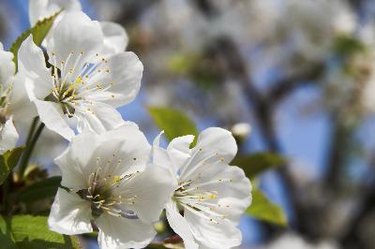
Leaves falling off trees it is known as defoliation. Various causes exist for defoliation in cherries and other stone fruits. Leaf fall can be natural, as it occurs with most deciduous trees in the fall, or can be due to fungal disease, bacterial disease and improper watering.
Natural Leaf Fall
Video of the Day
In the fall, when temperatures get cooler and there is less daylight, the leaves of the cherry tree stop making food. Chlorophyll, the green color of leaves breaks down and exposes yellow and orange pigments, called carotene and xanthophyll. At the same time, cells develop in the area where the leaf stem attaches to the tree and gradually severs the leaf so that it is blown away by the wind or drops under its own weight.
Video of the Day
Bacterial Diseases
Bacterial spot, caused by Xanthomonas pruni, and shot hole, caused by Pseudomonas syringae, are similar diseases. Leaf symptoms are the most obvious. Wet spots appear on the underneath of the leaves, turning brown or black and falling out to leave red rims. Heavily infected leaves turn yellow and fall. Twigs infected in the autumn harbour the disease over winter. Wet, windy weather spreads the disease. Avoiding nitrogen-heavy fertilizer curbs disease development as do some copper fungicides.
X-disease, caused by a mycoplasmal bacteria affects many stone-fruit trees. Six to eight weeks after the beginning of growth in newly infected trees, the leaves turn red to orange and fall. In future years, small, yellow leaves grow in tufts. The tree dies after being infected for three years. The disease is transmitted by grafting and leafhoppers. Disease-free planting stock, isolation of new plantings and removal of infected trees are the only control measures available.
Fungal Diseases
Verticillium wilt is caused by Verticillium alboatrum. Leaves appear pale in the early summer and then drop without wilting. Leaf drop starts at the base of infected branches and progresses upward. Trees that have been affected for several seasons are stunted. The fungus invades via the roots and the use of susceptible rootstock increases the risk of infection. Trees may recover if infected branches are removed and vigorous growth is promoted with fertilizer and watering.
Cherry leaf spot is caused by Coccomyces hiemalis. Spots on the leaves, 1 to 3 mm in size, become yellow progressing to brown, and heavily affected leaves turn yellow and fall. Trees can be completely bare by midsummer if the infection is severe. The fungus survives in fallen leaves, so leaf removal can help prevent infection.
Overwatering
According to Pat Fugal, a Master Gardener for Utah County, trees do best with deep watering once every one or two weeks. When trees are located on or close to lawns, or other areas where plants are watered frequently, they may be overwatered. In addition to causing leaves to fall, overwatering can also cause poor general growth ad yellowing of leaves.
- State University of New Yor; College of Environmental Science and Forestry; Why Leaves Change Color; Carl E Palm Jr
- North Dakota State University; Disease Control in Cherries, Plums, and Other Stone Fruits; H. Arthur Lamey and Robert W. Stack; July 1991
- Utah State University; FAQ; Pat Fugal; 6 August 2008
- TreeHelp: Cherries Insects and Diseases